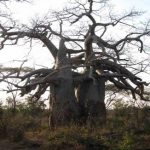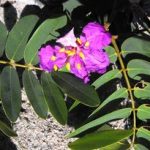TREE LIFE
November 2013
MASHONALAND CALENDAR
15th – 18th November: Outing to Seldomseen in the Vumba for those who have booked. Please email Mark Hyde asap if you would like to join us.
Saturday, November 23rd: Visit to Mukuvisi Woodland: This month’s afternoon walk will be at the Mukuvisi Woodlands, Blatherwick Road entrance. We will meet at 1430 hrs. Mark to lead.
TREE OF THE MONTH
Terminalia sericea
Family: Combretaceae. Common names: Silver Terminalia, silver cluster-leaf; Umangwe (Nd) , Mususu (Sh).
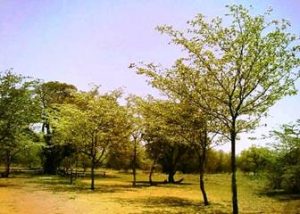
Terminalia sericea
The Combretaceae family is well represented in Zimbabwe with over 30 species. Terminalia sericea grows in grassland and open woodland with a preference for sandy soils at lower altitudes, often growing at the edge of wetlands where the soils become slightly drier. It is deciduous and grows to some 12 m in height, sometimes more but often less. The crown in mature trees is round to oval.
The bark is dark and fissured longitudinally. The twigs are blackish and the bark peels off showing the light-brown under-bark; twigs are often deformed by elongated galls. The leaves are spirally arranged toward the end of the branchlets, hence the scientific name “Terminalia”. The obovate leaves are silvery-grey and silky – sericea refers to the silvery appearance of the leaves. The flowers are greenish-white, small and inconspicuous, but the fruits are two winged, red to purple-brown and very showy.
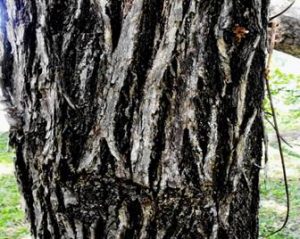
Terminalia sericea bark
Terminalia sericea is important in traditional medicine – the leaves and roots are boiled in water and the infusion is taken orally for the treatment of bilharzia, pneumonia, coughs, diarrhoea and stomach aches. The leaves can be used as an antibiotic for wounds. In the case of bleeding, a paste can be made by cooking the leaves in water and placing them on the wounds. The bark is used against diabetes.
This species produces a good timber, dense and hard but difficult to work. The wood is also used as a source of energy for cooking and is a preferred species for constructing huts and for fencing material because it is borer and termite resistant. Leaves provide food for caterpillars during the rainy season.
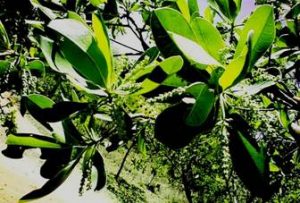
Terminalia sericea flowers
Sources:
Van Wyk, B. & Van Wyk, P. 1997. Field guide to Trees of Southern Africa. Struik, Cape Town.
Plantz Africa: www.plantzafrica.com
– JP Felu
TREE SOCIETY VISIT TO MALILANGWE CONSERVATION TRUST, CHIREDZI, 29th August – 2nd September
Day Three – Saturday 31st August
During a weekend of highlights, to see how the bush has been trashed by elephants was definitely not one of them and most certainly did not add to our pleasure. The elephants must have realised this and kept out of sight so that on Saturday only some of us actually saw one of them at dusk. We did see lots of other game including a nice herd of buffalo as shown by the pics posted on the Tree Society Facebook page. But we were looking at trees and in total I recorded 140 species of trees, honorary trees and other plants, including a number that do not occur in our part of the world. So it was a very exciting trip.
Thank you to Isla for organising the trip and Karl for all he did, including working out the programme. Sorry his vehicle put a spanner in the works of the best-laid plans but it all worked out in the end.
The folks at Malilangwe were very good to us and on Saturday morning Marco piled us all into his bakkie and took us for a game/ tree viewing drive to the confluence of the Chiredzi and Runde Rivers.
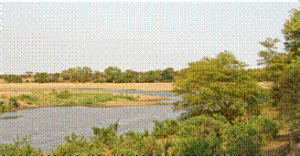
Confluence of Chiredzi and Runde rivers
I always think that seeing the confluence of two big rivers is something special. From where we were standing there was an Acacia robusta subsp. clavigera, Splendid thorn, looking splendid indeed in full flower, almost hiding the actual junction of the two rivers. There were also some fever trees, Acacia xanthophloea, conspicuous with their yellow bark. That bark is so distinctive they can be recognised even when they are very small.
We mostly travelled through both open woodland on sand and mopane woodland, stopping several times to look at and identify trees. The woody liane above had a trunk of about 20 to 30 cm in diameter. The leaves were hidden among those of the Berchemia discolor, Bird plum, up which it was growing, so Karl climbed up to get some and solved the mystery. It was Capparis tomentosa, Woolly caperbush. This has pairs of hooked spines at the base of the petiole and these are often persistent even on the large trunks – we did eventually spot them but quite high up. During the trip we also saw the other species of Capparis, C. sepiaria, Hedge caperbush. Sepiaria means ‘to form a hedge’, hence the common name. It does make a very good hedge, being bushy with pairs of curved, sharp spines that form a strong deterrent. The commercial caper of the culinary world is obtained from the flower buds of Capparis spinosa and those of the Hedge caper bush are sometimes used as a substitute.
Another very spiny species we saw and I photographed because I thought / hoped it was Gymnosporia putterlickiodes, Large-flowered spike thorn, in fruit. The fruit I presumed were still quite immature because they weren’t obviously 3-lobed. But it turned out to be Gymnosporia senegalensis, Confetti spike thorn, when we checked it in the Herbarium.
After a delicious lunch provided by Marilyn and Vernon and a quiet snooze, Bruce Clegg, the ecologist at Malilangwe, came over and he too very kindly piled us all into his bakkie and we spent the afternoon looking at a wealth of trees. First as we came out of the gate there was Commiphora edulis, Rough-leaved corkwood, which as they were all standing bare, we had not recognised. This is locally known as jefu-jefu and is used to produce fire by friction.
The next stop was to look at some species that are evergreen and so have to defend themselves against herbivores, otherwise they would have been eaten and disappeared long ago. The first is what is currently known as Maerua decumbens, Blue-leaved spiderbush. With very grey-blue leaves this is so low growing that it lies on the ground with the end of the stem standing upright, which is the definition of decumbent. It is poisonous and used as a fish poison. I first knew it as Courbonia glauca and Bruce told us that the late Bob Drummond questioned it being included in the genus Maerua because all those species are edible and this one is most definitely not. They belong to the caper family, Capparaceae, whose members produce mustard-oil glucosides. Knowing that, I am always surprised at how many species in the caper family are popular with browsers. Thilachium africanum, the Cucumber-bush was the next one he pointed out and in the dry bush it does stand out with it’s dark green trifoliolate and sometimes simple leaves, which are poisonous. During the trip someone was delighted to find a fruit which is apparently edible and eaten by monkeys and that could explain why the fruit are seldom seen. Bruce also pointed out the very leathery leaves of the Rain-tree, Philenoptera violacea, which have little food value. And this reminded me that although all the browsing and grazing animals’ diet is vegetation, they can’t actually digest cellulose and so have a gut of four chambers, full of symbiotic bacteria to do it for them. I remember noticing an area at Mana Pools where there was a whole lot of regenerating, low-growing Philenoptera violacea and half wondering why they hadn’t been browsed.
I wish I had taken more notice of the Phyllanthus pinnatus, Sand potato bush, at the time. It is in the book and so I recognised the name, but in retrospect, I really don’t think I have seen it before. According to the key the leaves have a midrib that doesn’t quite reach the apex, and having looked at the specimens I brought back I see this is quite true. I could see that it is different from Phyllanthus reticulatus, Potato-smell, which I do recognise quite easily. When it flowers or fruits it is easy to see which species is which. The Sand potatobush has separate male and female flowers but on the same plant (husband and wife in the same house but in different beds) and the female flowers and subsequently the fruit are borne on long slender stalks about 2,5 cm long. The fruit are distinctly three-lobed capsules. Whereas the Potato-smell has hermaphrodite flowers (husband and wife in the same house in the same bed) and the fruit are round berries borne on short stalks. That well-known evocative potato smell of the rivers at lower altitudes in the late afternoon and early evening is the scent from the buds and flowers and obviously that is the time when the pollinating insects are around.
Another species which I had misidentified turned out to be Maerua parvifolia. This is supposed to be a small shrub but what we saw in flower was right on the ground, little more than ankle-height and certainly not Boscia foetida subsp. rehmanniana, which is usually distinctly a tree.
Albizia petersiana, Many-stemmed false thorn, was another exciting species. It is multi-stemmed, branching near the base with erect branches at a slight angle, giving a very distinctive V-shaped appearance. The leaves with two to four pairs of pinnae, each with two to four pairs of obovate to roundish leaflets, can be confused with those of Albizia anthelmintica, Worm-cure Falsethorn, but the leaves of the latter are hairless with a little hook at the end of the rachis and the tree is usually spiny. Another distinction is that the Worm-cure falsethorn flowers early in the season, July to September, before the new leaves and the Many-stemmed False-thorn flowers with the new leaves from about November onwards.
As we drove past an Acacia Bruce said ‘’that’s the mystery Acacia’’ and, being able to recognise it as Acacia sieberiana var. sieberiana because I have seen it Mozambique, I stupidly didn’t ask him to stop so that I could photograph it, collect a sample and record the GPS position. The reason I should have done so is that I don’t think it has been recorded as occurring in Zimbabwe before. It is actually quite distinctive and I have seen it on the side of the road somewhere near Ngundu Halt when I have been travelling to South Africa, so I know it occurs in Zimbabwe, but I need to prove it – I have not stopped to record those positions either. Var. sieberiana has a trunk with a smooth or roughish, but certainly not a papery bark; the branches are hairless, orangey-yellowish, somewhat resembling but not as yellow as the bark of the fever-tree; and ascending at an angle of about 45° so the trees do not form a flat top like the very common var. woodii that we know so well often does. The pods of var. sieberiana are also quite thick and woody but not as broad and much longer. I measured one in Mozambique that was 23 cm long. One can be so clever in hindsight! I am very excited about this especially as Bruce didn’t know what it was and I am very sorry we didn’t stop that late afternoon so I could have shown everyone something really new. I am afraid you won’t find more than a passing reference to it in any tree books, but I will do something about describing it for the next edition of Palgrave’s trees.
That exciting tree we saw on the way to all sorts of other things: Schrebera trichoclada with it’s tell-tale wooden pears, which when they are open look a bit like the open mouth of a hippo; the Poison-pod falsethorn, Albizia versicolor; Synaptolepis kirkii with a very poisonous root bark, which can’t be seen, but with both opposite and sometime alternate leaves borne on brown stems with lots of lenticels (little white dots or corky breathing spots) which are distinctive and can be seen; Balanites maughamii, Y-thorned torchwood, which I think has been called after someone Maugham, and therefore should be pronounced ‘’morm-ii’‘ and not “mor-gam-ii”. These trees have leaves with two leaflets so they are bifoliolate and their most distinctive and obvious feature is the forked or y-thorns; Strophanthus kombe, Poisonpod tail-flower. Several people were given one of these un-opened pods. If any of their in-laws suddenly die we will have to make enquiries. The poison, strophanthin, is in the seed. When Livingstone and Kirk ventured up the Shire River they were fired at by the ‘natives’ with arrows poisoned with strophanthin. They obviously missed and Kirk kept his arrow to hang on his wall when he retired in England many years later.
On our way home as we went through the sand of Ray’s Crossing over the Chiredzi River we were lucky enough to see a young hyena in the headlights and when we were almost back to camp we saw a pair of honey badgers, the cherry on the top of a wonderful day.
– Meg Coates Palgrave
Day Four – 1st September, Gonarezhou
Our 4th day at Hippo Camp dawned overcast but cleared up quickly. We were making for Gonarezhou so we had an early start with quite a few stops on the way.
Our first port of call was Manyuchi’s Tree, Cordyla africana, on the North Bank of the Runde River, still in Malilangwe about 7 km from Chipinda Pools. This majestic specimen has a crown diameter of 55 m, with 4½ human arm-spans round the trunk. Ernest Rubridge Morkel, one of the early Native Commissioners in the country, used to camp regularly under the tree and was known to the local people as Manyuchi (because he used to sting like a bee). It is now listed as one of the Historic trees of Southern Africa in Lyn Mullin’s book.
We then visited the concrete bridge which used to span the Runde (Lundi) River. This huge solid bridge had been washed away in 1970 by the floods caused by a cyclone and had never been repaired. The large trees being carried by the floods had all caught behind the bridge until their combined weight and pressure of the water had broken the strong concrete span, which was hard to imagine on this peaceful, sunny day at the end of the dry season, with little water flowing in the river.
Our next stop was the campsite on the Runde River inside Gonarezhou, After a lovely picnic lunch we decided to identify some of the trees along the river bank. There were some very large Mimusops zeyheri (Transvaal Red Milkwood), and Diospyros mespiliformis, African Ebony, down by the water, and further up the bank we found Manilkara mochisia, Lowveld Milk Berry, Thilachium africanum, Cucumber Bush, in flower with its white to cream stamens; Combretum mossambicense, the rambling Shaving brush Combretum with its long stamens that make the flowers look just like little shaving brushes; and the climbing Acacia schweinfurthii, River Climbing Thorn.
Once the afternoon had cooled a little, we drove up a rocky incline and came across some very interesting trees. Amongst them were Euclea divinorum, Magic guarri; Gymnosporia senegalensis (formerly Maytenus), Red spike thorn; Lecaniodiscus fraxinifolius, River Litchi; more Thilachium africanum, cucumber bush and Balanites maughamii, Y-thorned torchwood and Acacia robusta, Splendid Thorn, flowering in creamy white globose heads; Canthium glaucum; Cardiogyne africana, African Osage-orange, and our great find, the Adenia fruticosa subsp. simplicifolia, Greenstem, with its massive swollen trunk and greeny-yellowish flowers.
Driving on to the dam for a cool drink by the water, we came across Mundulea sericea, Cork bush, not yet in flower; Boscia albitrunca, Shepherds tree; as well as Acacia tortilis, Umbrella thorn, which were plentiful everywhere in Malilangwe. We also saw Acacia welwitschii , Delagoa Thorn, Salvadora persica, the Mustard or toothbrush tree, and Ochna barbosae, Sand plane.
We then made our way back to Hippo Camp as darkness fell, having had a very informative day.
– Vernon & Marilyn Dickinson
Meg Coates Palgrave adds:
On the afternoon of the first day we had looked at Acacia welwitschii, and wondered if the photos in the van Wyk book were correct. I had another closer look and am happy that they are fine.
On the second day when we visited the Stables we saw two unusual Vitex, which I thought / hoped were Vitex mombassae and Vitex schliebenii, but in fact although one was 3-foliolate and the other was 5-foliolate I think that they were both the same species, Vitex patula, Sand Fingerleaf. This species has a very limited distribution so is another exciting one to see. The leaves are quite rough on top – FZ describes them as ‘scabridulous, not bullate and with gland dots on the undersurface’. The gland dots are few and far between and minute, but they are there. The leaves are most certainly are not bullate (puckered between the veins). The photos in ‘The Trees and Shrubs of Mpumalanga and Kruger National Park’ show them as being very puckered between the veins so that did have me wondering. Just proves there can often be huge variation in plants and in botany we should never say ‘never’ or ‘always’!
I have prepared a copy of the full plant list if anyone would like it.
– Meg Coates Palgrave
Monday 2nd September
The next day being Monday, the group packed the vehicles and prepared to leave. Luckily Karl had been able to bring down another vehicle with his driver the day before so he and Annelie headed back to the Stables to sort out their dead vehicle. The other three vehicles made successful last crossings of the Chiredzi River at Rays Crossing and headed for the main gate. As our vehicle entered the woodland on the other side of the river we came across a herd of more than eight giraffe with young and were happy to delay our departure for several minutes to watch these beautiful creatures, some of the darkest I have ever seen. As we went through the gate I stopped to photograph a spectacular group of Adenium multiflorum, Sabi star, in flower.
We had had such an interesting few days identifying the many trees, shrubs and herbaceous plants that we came across, which for many of us rekindled an interest in the trees of the Lowveld. My thanks to Meg and the Tree Soc. group for making it such fun.
A special thank you to all the very welcoming and helpful Malilangwe staff we came across and thank you again to Mark Saunders for organising our stay.
- Isla Grundy
Tree Society Visit to Botanical Gardens, 20 October 2013
Led by Meg Coates-Palgrave
This was a rapid substitution for the planned visit to Raintree Gardens which unfortunately fell through. Meg however felt that there would be merit in looking at the flowering trees in the Botanic Gardens and this indeed proved true.
Albizia glaberrima – the little copse of three huge trees, Lowveld Albizia, just outside the restaurant, proved a shock; one had been cut down and chopped into small pieces and the second was looking very stressed with deep, fresh stress cracks where the first branching of the stem took place. Paripinnate leaves which end in a matched, larger pair of leaflets. New leaf colour was a rich red.
We paid homage to the empty spot where a group of Acacia xanthophloea once stood. They had all succumbed to Armillaria fungal attack. Then Cordyla africana, the Wild mango, part of the pea family but producing fleshy fruit and not pods, caught the eye. Its seed deteriorates if allowed to dry out and they often start germinating whilst on the tree. They must be carried away from the vicinity of the mother-tree to complete germination successfully. Leaves are imparipinnate, alternate.
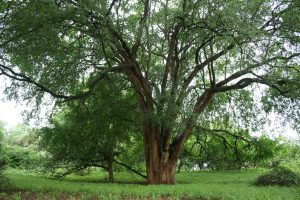
Xanthocercis zambesiaca; Photo: Bart Wursten
Shashe River; https://www.zimbabweflora.co.zw
A very unhappy Xanthocercis zambesiaca was lying almost horizontal nearby and through all our minds flashed images of our own personal favourite tree, usually with a nyala with its head stuck in the neatly trimmed canopy, somewhere in the Lowveld areas of Zimbabwe. From Birchenough Bridge in a broad sweep from East to West, the Nyala trees are probably the most iconic of the Lowveld, baobabs aside. Also a pea family member with fleshy fruit.
Then a gem, just next to the riverine forest trees, Lonchocarpus capassa, now called Philenoptera violacea, the Rain tree and sure enough from foamy middens on its branches, sap was dripping copiously out and splashing onto the ground below. The culprit, nymphs of froghoppers (Ptyelus grossus) suck the sap and it quickly passes through the digestive system and comes out as a clear liquid. The pinnate leaf has stipules at the base of each leaflet and the terminal leaflet is usually larger. It is a low-altitude tree – the specimen we inspected was planted in 1988 and had just about completed a magnificent show of violet flowers.
A scrubby Combretum mossambicense was next, the Shaving brush Combretum with its distinctive white flowers. Also a marker for identification were the spikes left behind when the leaves shed and these allow the bush to clamber over any and everything nearby.
Growing next door, with a host of parasites in the upper canopy, Cordia africana was laden with its saucer berries and their persistent calyxes. These fruit are favourites with bats and if near your house they will splatter the walls with their waste products.
One of the greatest trees of the African Bushveld, Kigelia africana, gave some deep shade on a fiercely hot day. Sausages were in abundance above our heads and on the ground, the litter of recently fallen flowers. Clearly visible were the strings which hold the flowers and Meg related how, once one flower is pollinated, then all the rest abort and only one huge sausage will be suspended from the branches for a year or more until grown fully. Bats do the pollination (flowers open at night) and game relish the fallen flowers and everybody likes the nectar in the maroon flowers. Kigelia is well known as an extracted cream from the pods, to apply to undesired skin blemishes where it has a good reputation for keeping dreadful carcinomas at bay. The fruits are eaten by baboons, porcupines, rhino and elephant.
Phyllanthus reticulatus, a very innocuous looking shrub on the edge of the forest, gave us a tantalizing aroma that gives it the common name of potato bush. It flowers at night and that is when the scent is strongest.
A huge Euphorbia ingens was in its last throes of dying and we left it to quietly pass away in dignity. Apparently there are some fungi attacking them in South Africa as well.
Commiphora viminea (syn. C. merkeri is now believed to occur in East Africa only) planted in 1978, next caught the eye with its distinct zebra-marked bark. They have simple leaves in rosettes, with no petiole. The branches sport a spiny tip probably to deter browsers, but elephant show no respect and love shoving these trees over.
Amongst the Commiphora was a little baobab, Adansonia digitata and its bark, lightly scratched, revealed the distinct green of chlorophyll-charged tissue. At the top of the tree new leaf was visible, but only just.
The great botanist who accompanied Livingstone, John Kirk, had a whole genus named after him and Kirkia acuminata is one of the most recognisable of these trees. It also has the green of chlorophyll in its bark and the added lenticels which allow the trunk to breathe. In April as White Kirkia, they pepper the Lowveld landscape with their leaves yellowing just before they fall off.
Cordia ovalis or the sandpaper Cordia, or toilet paper tree, had rough and raspy leaves and I am sure the last use for these appendages is the descriptive name.
Our group was so disappointed with what the brash Australian botanists have done with the nomenclature of the acacias that we spent only a cursory moment with Acacia mellifera, although the tree deserved much more.
Standing alone in the dry grass was a lone Colophospermum mopane, the Mopane tree. With bifoliolate leaves, it is still struggling to get to terms with the Highveld environment after more than thirty years and its branches were rigidly intransigent.
By now the heat was intense so we retreated into the woodland where Vepris lanceolata had established an ironwood foothold. True to form its crushed leaves emitted a distinct citrus-like smell from the numerous glands dotted throughout. The leaves are trifoliate and we could see from some nascent buds that the tree would soon be in flower. These come directly off the branches.
Vitex buchananii or the Orange-fruited Vitex was the next encountered. More often than not it is a liana, but here it was a tree. In the middle of a clearing was a multi-stemmed tree with the trademark, yellow to grey coloured bark of Millettia stuhlmannii, Panga Panga. The very name rings of the excitement of early loggers felling the huge stands of these wonderful trees to use the dark hardwood for railway sleepers, flooring and exquisite furniture.
Rhus gueinzii (now Searsia) was seen next on the woodland edge. The Thorny Karee, it has a hard red wood but is rarely used. Diospyros lycioides attracted some attention but it had an eye-level, resident toppie’s nest and we had to leave both bird and tree in peace. Common name is the Red Star Apple.
Gardenia resiniflua has a very distinct marker in that the leaf buds exude some yellow resin that is believed to lubricate the opening of the new leaves. The fruits are derived from an inferior ovary so that the petals and sepals, as well as the persistent calyx that remains, mark the top of each fruit.
An indistinct Aloe species riddled with white scale was found languishing near the edge of the tree line. It needs some tender loving care soon.
Then the piece-de-resistance for the day appeared like a giant sailing ship, with branches ablaze with yellow buds and white flowers sweeping right down to ground level, Albizia versicolor the Poison pod Albizia. The flowers that we saw will only result in mature pods in July to September next year, The tree derives its common name from the poisonous attributes of unripe fruits if consumed by cattle. Unripe pods are usually bright red, so beware! Stipules occur at the base of the bipinnate leaves.
Another magical kingdom loomed out of the edge of the rainforest. Ficus rokko, famous as one of the entries in Lyn Mullin’s book The Historic Trees of Zimbabwe, which resides in Mutare, quite illogically, on Oak Avenue in Murambi. It is fairly commonly found in the Eastern Districts rainforests and moist Miombo woodlands. The roots descending dramatically from horizontally extended branches allow the tree to march slowly but inexorably through the forest.
Filicium decipiens lurked in the deep shade of the rainforest and looked deceptively fern-like. As a member of Sapindaceae its paripinnate leaves have a winged rachis which is distinctive.
Trilepisium madagascariense eluded us until we triumphantly found a label in the canopy. Its shiny leaves with a very long drip-tip to each labelled the tree conclusively, especially as it had a milky latex when the bark was scratched. The petiole appears to be stuck onto the leaf and this tree also has lenticels on the stem. Its common name is the Urn Fig.
Another citrus-type tree was spotted, Teclea nobilis the Giant cherry orange. On the open edge of the forest Peltophorum africanum was about to burst into bright yellow flower and its fern-like stipules were much in evidence.
Because of their intrinsic beauty we threw aside our prejudices with the Australian naming system and languished in the shade of two Acacia abyssinica spp. trees which have pride of place in the eastern side of the Botanical gardens. We say spp. because these two trees have broad low branches which reach out and their shade beats the sun’s rays back relentlessly. They are from Kenya and have a markedly different shape from those derived from Zimbabwean stock planted in neat cathedral-like rows outside the offices of the Gardens. You need to go and see them all to appreciate the difference.
The open structure and very obvious large white pods of Entada abyssinica with segmented seeds each held in a wafer-thin piece of parchment meant that this tree was identified immediately.
In the woodland we walked past many typical Miombo trees and the crack of dehiscence above us led to some discussion about the distinction between Julbernardia globiflora , the Munondo, and its more glamorous cousin, Brachystegia spiciformis, the Musasa.
Ficus craterostoma with its flat-ended leaves was also easy to identify. The Forest fig, there is no doubt where it thrives. Nearby and sweeping down from the forest canopy were branches of Newtonia buchananii, whose fruits only open down one side and leave a flat pod that is no longer recognisable as a fruit.
To end the day, in the shade of a majestic Ficus sycomorus, Meg regaled us with Biblical tales and almost unbelievable sagas about how specific wasps invade the figs to pupate, feed and pollinate the internal flowers before forcing their way out. The male has to free the female, mate with her and then she flies off and the cycle continues. Above us the branches of the tree were heavily laden with thousands and thousands of figs awaiting the perfect moment when the gas balance in the figs reaches a critical level and ripening occurs.
– Rob Jarvis
New book on South African Flowering Trees, by Rob Wood
Print Matters (SA) is offering a pre-launch price for their new illustrated book on South African Flowering Trees, which comes in hardback and softback as well as in special subscribers and collectors volumes. The deadline for ordering the latter volumes was 31st October, but worth contacting the printers if you are interested. Please email the Tree Society if you would like to see their brochure.
– Ed


